
Introduction
With the beginning of the lockdown to control the Covid-19 outbreak, many educational institutions have started switching from traditional classroom teaching to online teaching to cope with the adverse situation. Tribhuvan University (TU), the largest and oldest university in Nepal, has also officially endorsed the virtual class model along with a guideline and circulated a notice among its institutions. Similarly, the Ministry of Education, Science and Technology has appealed to stakeholders to start classes through alternative systems. Various news media and relevant stakeholders have argued for the need for promoting such classes.
Nevertheless, there are some critical questions in the context of Nepal. Do all students have access to the quality internet to attend the classes without disturbance? Are the teachers well equipped and trained enough to run the virtual classes effectively? Moreover, are all the students able to use this opportunity of distance learning?
Here is an observation based on a recent experiment. We do hope this experience works as a part of remarkable feedback to concerned stakeholders to make their virtual class effective and organise with efficacy in this lockdown or any similar situation in the future.
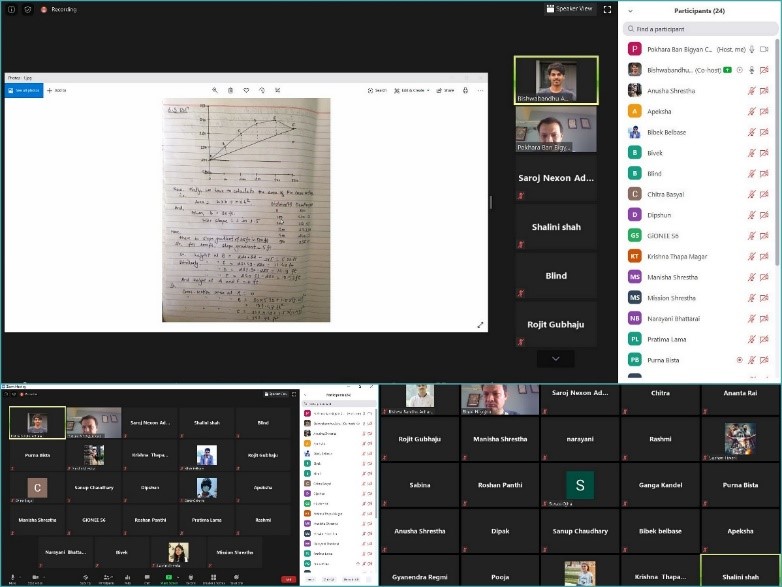
In his efforts to examine such concerns, before the TU issued the detailed guideline on online classes, the first author had already started online classes for his bachelor’s level forest engineering students, using Zoom, on April 18, 2020. He completed a section of his course in 29 days, which in traditional classes would normally take 20 to 25 lecture hours only. The students’ average turnout was about 50% and the students interestingly received the class in a participative manner (Figure 1).
The class ended on May 16, 2020, by evaluating overall learning experiences and soliciting participants’ views on continuing such classes for other courses.
Evaluation
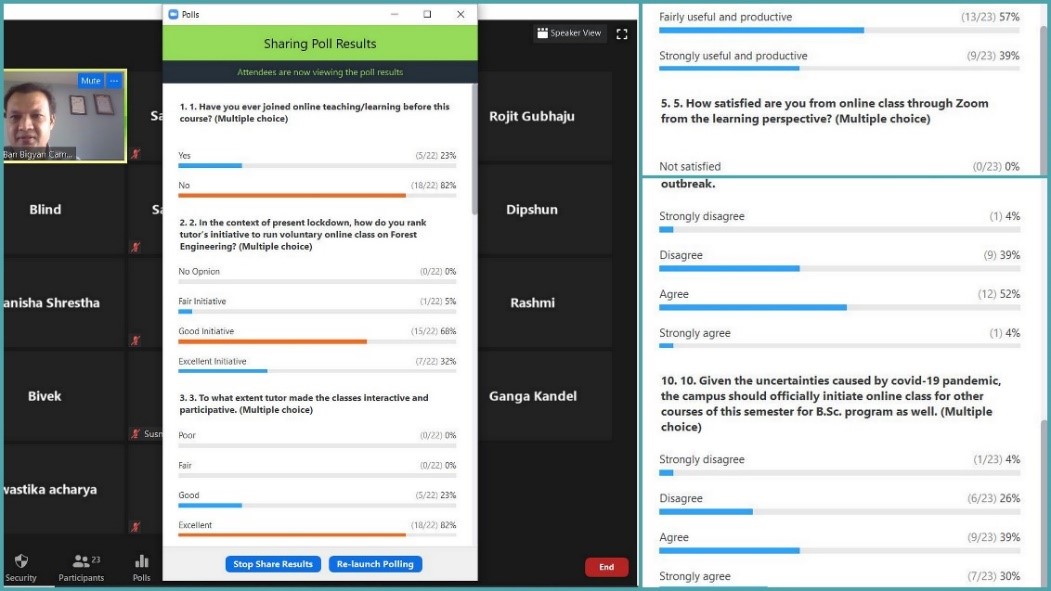
The polling option available on Zoom was used to solicit student’s perceptions of the class. The turnout during the poll was low perhaps due to power breakout in many students’ end. However, the opinion collected from 23 participants can be representative of all the students participated in the online class. The 10 questions, close-ended in nature, were asked in three main aspects such as students’ learning experience in current classes, status on students’ access and use of the internet, and their views on continuing online classes for other courses (Figure 2).
Results and discussion
The response on the students’ learning aspects shows that the level of learning is satisfactory despite this teaching method being new for them. The respondents have rated the teachers’ efforts to make classes productive as “high”(Figure 3).
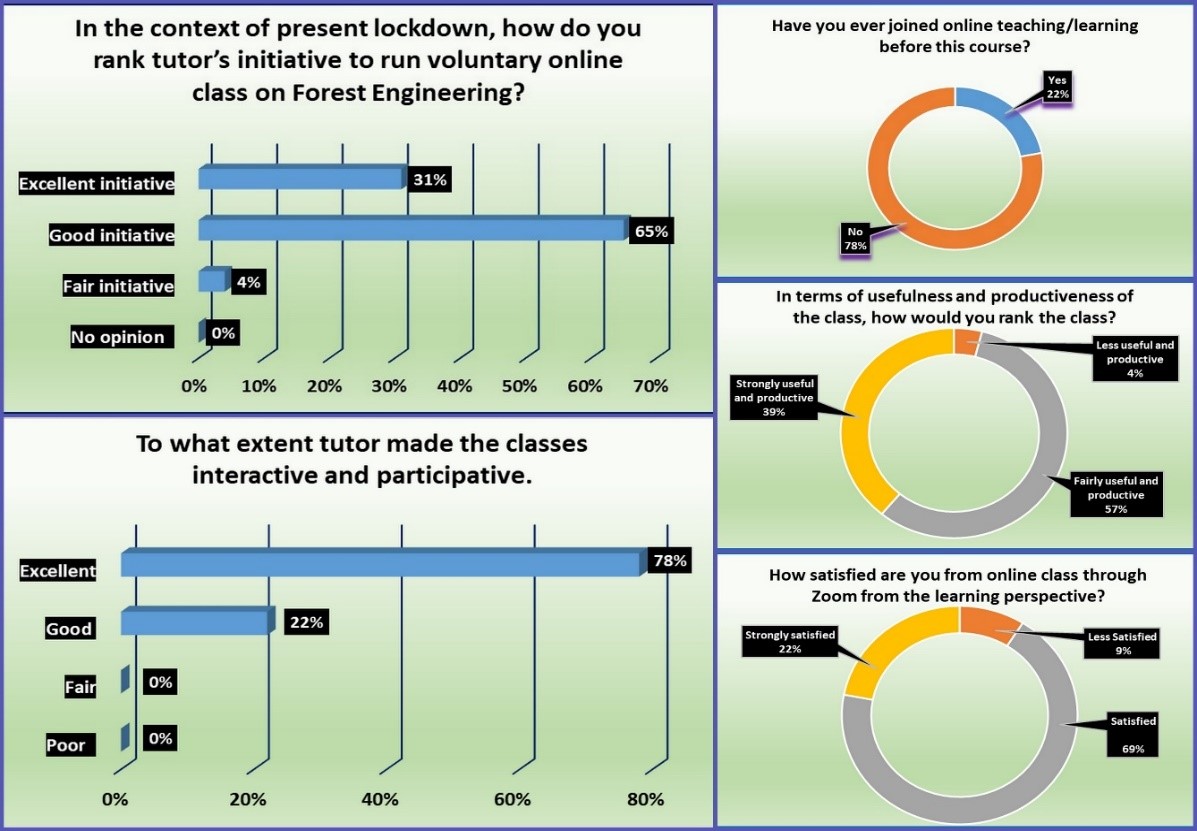
Switching from a traditional classroom and face-to-face instructor training to computer-based training in a virtual classroom makes the learning experience entirely different for students. Their resistance to change does not allow them to adapt to the online learning environment. However, the tutor attempted to employ good practices to make the class interesting and the students fully cooperated. The main practices included planning for the class, preparing and mastering technology, stimulating discussions, keeping communication regularly with students, motivating to them and asking help and feedback from the students.
In the above scenario, it is not possible to run online classes for all the students. However, such classes for almost half of the students can be initiated followed by real classes for remaining students after the lockdown is over. This could help keep the students engaged in lockdown and minimise real class time later. Further, the tutors or students can share the recording of each session to their friends, who cannot join classes. Motivation and dedication are other factors that trigger students to participate in online classes.
Because this teaching method is new to them, students might lose attraction and subsequently give up the classes. Informal interactions with the participants of the classes reveal that the turnout could have been better had the class been announced as compulsory to all. It is, however, imperative to carry out feasibility analysis and identify the necessary challenges in a participative manner by the concerned stakeholders before launching such initiatives.
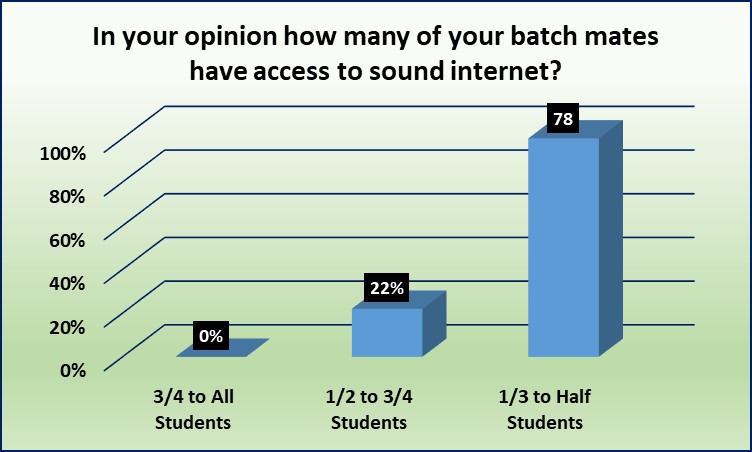
About the second aspect (the students’ access to the internet), the result (Figure 4) is not encouraging and this represents the normal scenario in Nepal. Nepal Telecommunications Authority in its recent report shows that over 72 per cent Nepalis have access to the internet, but a majority of them depend on mobile data with just 17 per cent of them having access to fixed broadband connections. Sound internet connectivity has been one of the most complained aspects and accessing online courses through mobile internet is expensive, which is unaffordable for many students.
Limited availability of technological infrastructures in academic institutions and at the homes and digital literacy among the stakeholders involved in the teaching-learning process are other obstacles that affect the effectiveness of online classes. In this context, these classes may lead to inequality within the student community as well as infringe on the right to education of those clusters of students who do not have access to the internet and are unable to manage computers or smartphones for individual purposes.

Regarding the respondents’ view on the preference of replacing the classroom teaching with online classes, more than half of them appeared to support this in the present unprecedented situation (Figure 5). Although they are concerned that some of their friends will be deprived of the opportunity, they apparently want to remain engaged, attending online classes during the lockdown.
Conclusion and recommendations
Three-quarters of the respondents feel that concerned academic authorities should officially initiate online classes regularly at the bachelor’s level also (Figure 6). The respondents might have opined this based on the present class experience in which both tutors and students worked together collectively for good learning experiences. Generally speaking, the teaching method is new for both teachers and students and the experience suggests that teachers have to prepare more and use the technology’s potential to make the classes interesting and keep students focused.
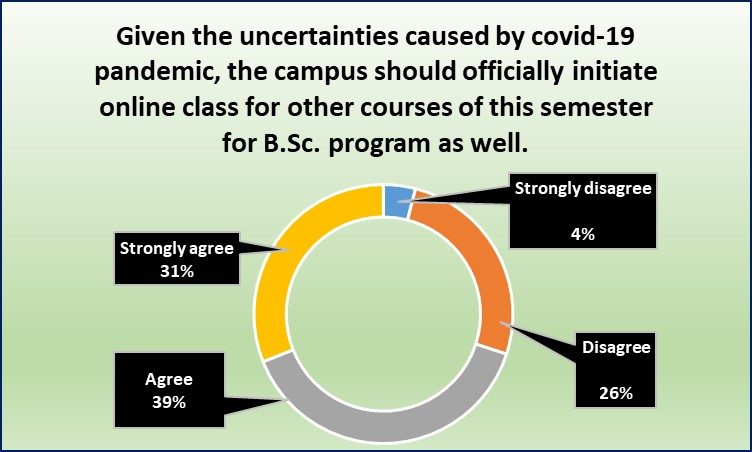
The evaluation suggests that virtual classes could be an option to keep students occupied in their learning at this unprecedentedly difficult time. The concerns about some students being deprived of the opportunity are genuine and this requires some appropriate plan to address. In the situation of low broadband coverage in the country, students have to depend on mobile data and the cost is high. Hence, respective institutions should help them access low-cost student packages. The tutors’ digital literacy is important to make online classes attractive and more effective and this could require short training sessions to them.
The lockdown has certainly provided an opportunity to learn and master online communication. In addition, the situation has taught the government a big lesson to keep the communication sector more updated and emphasise digital aspects so that many hurdles can be combatted effectively even in critical situations.
All the writers are teachers.























